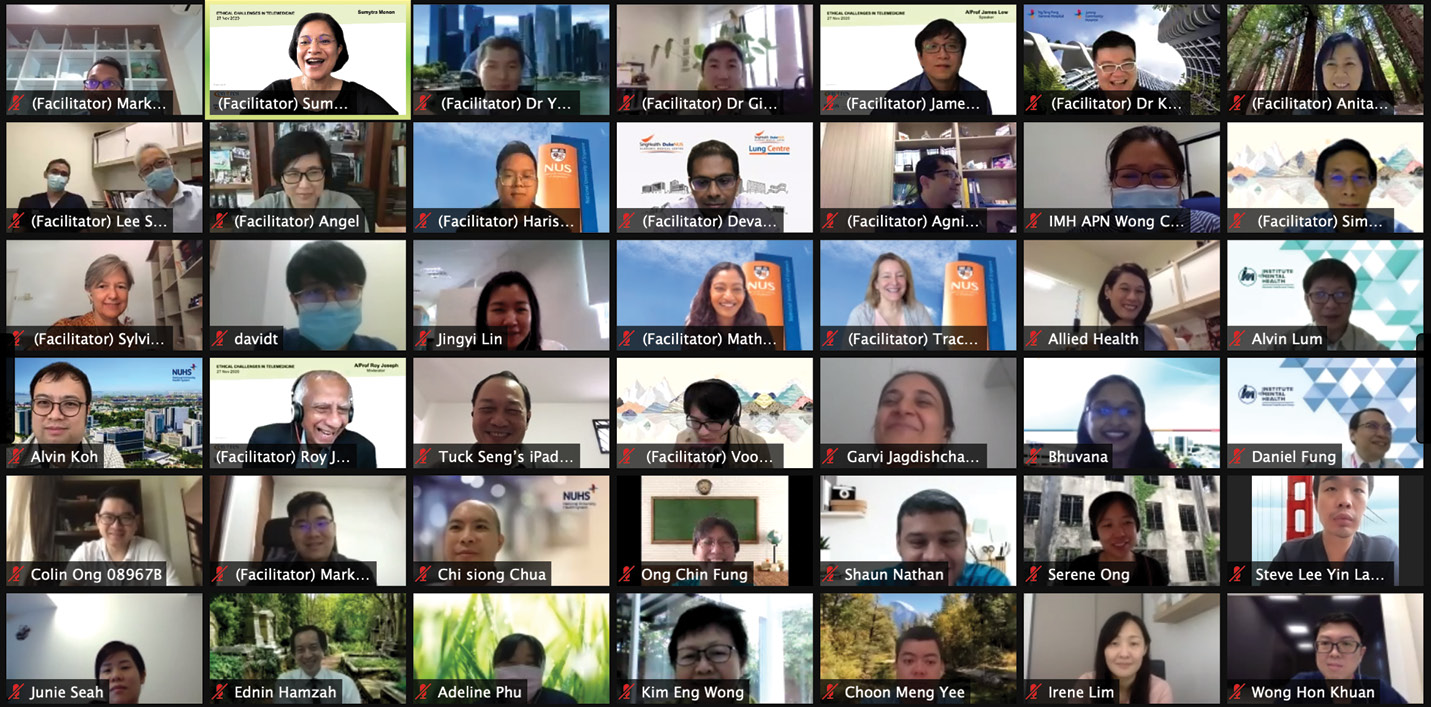
Issue 37 / February 2021
Ethically Speaking
Telemedicine Is Here to Stay:
Updates from the CENTRES Telemedicine Workshop

As communication remains largely virtual in the wake of the COVID-19 pandemic, uncertainty over how much longer this ‘new normal’ will last continues for the medical community. But with the passage of time, we are embracing technology that seeks to make our professional and social interactions more convenient and engaging, above and beyond safe-distancing mandates. Healthcare is no stranger to these developments.
n Singapore, many healthcare providers have shifted to tele-platforms, particularly since the Circuit Breaker period from April to June 2020. People are increasingly turning to telemedicine providers and apps like WhiteCoat, Speedoc, Doctor Anywhere, etc., through which designated local doctors can be contacted within a few minutes1. Consequently, several challenges have arisen, particularly regarding efforts to match the quality of care that has been provided through traditional modes of healthcare delivery. The National Telemedicine Guidelines 2015 (NTG)2, as well as the SMC Ethical Code and Ethical Guidelines (ECEG) require healthcare professionals to provide the same standard of care delivered by in-person consults3. Further concerns about how to practise telemedicine ethically include the maintenance of privacy and confidentiality, access and justice issues, obtaining consent to telemedicine sessions, concerns about liability and ensuring beneficence through maintaining a requisite standard of care.
In response to these concerns, on the 26 and 27 November 2020, the Clinical Ethics Network + Research Ethics Support (CENTRES) programme based at the Centre for Biomedical Ethics (CBME) organised a fully virtual, two-day Telemedicine Workshop. Nearly 250 participants, primarily doctors, nurses, healthcare administrators and academics, gathered over four sessions to deliberate on issues and concerns over ethical telemedicine delivery.
On Day 1, an expert panel comprising Associate Professor Chan Mei Yoke, Chairperson, Hospital Ethics Committee and Senior Consultant, KK Women’s and Children’s Hospital; Ms Rebecca Chew, Deputy Managing Partner, Rajah & Tann Singapore; Associate Professor Chin Jing Jih, Chairman of the Medical Board and Senior Consultant, Tan Tock Seng Hospital; and Associate Professor Raymond Chua, Group Director, Health Regulation Group, Ministry of Health (MOH) explored potential solutions to these challenges4, followed by small group discussions with the participants. Day 2 offered Senior Consultant, Geriatric Medicine and Palliative Care, Khoo Teck Puat Hospital Associate Professor James Low’s insights into practical and ethical challenges faced during teleconsultations in nursing homes and specialist outpatient settings5. Breakout discussions with participants on cases highlighting ethical issues that healthcare professionals may face during telehealth interactions with patients ended the workshop. The information shared by the experts and the robust discussions with participants charted a path forward towards better patient care in telemedicine.
Our Speakers at
CENTRES Telemedicine Workshop
Associate Professor Chan Mei Yoke
Chairperson, Hospital Ethics Committee and Senior
Consultant, KK Women’s and Children’s Hospital
Ms Rebecca Chew
Deputy Managing Partner, Rajah & Tann Singapore
Associate Professor Chin Jing Jih
Chairman of the Medical Board and
Senior Consultant, Tan Tock Seng Hospital
Associate Professor Raymond Chua
Group Director, Health Regulation Group,
Ministry of Health
Associate Professor James Low
Senior Consultant, Geriatric Medicine and
Palliative Care, Khoo Teck Puat Hospital
Privacy and confidentiality in telemedicine
Maintaining the privacy and confidentiality of both patients as well as practitioners is an ethical necessity in patient care. Given the inherent limitations and risks of technologies used in healthcare delivery, providers have a critical duty to implement safety features, utilise reliable platforms and meet cybersecurity standards, in order to avoid hacks and data leaks.
As Assoc Prof Chin noted during the panel session, practitioner responsibility in ensuring privacy of the patient, especially in multi-member households where others might inadvertently or intentionally listen in, is equivalent to that of in-person consultations. This duty extends to requesting that patients participate in the consultation in a suitable environment, one that is quiet, and free from disturbances.
Nearly
250
participants
gathered over
4
sessions
to deliberate
on issues
and concerns
over ethical
telemedicine
delivery
Deciding who should participate in a session is also important. A patient may want to include family members or caregivers. Practitioners may want to include others as well. For example, in consultations with minors, they should be accompanied by chaperones, especially in sensitive physical examinations when practitioners of the opposite sex are involved. Assoc Prof Chan recommended that in such cases another representative from the practitioner’s end should also be present, in order to increase patient comfort.
In light of apprehensions about the ease with which teleconsultations can be covertly recorded, Ms Chew suggested that practitioners also look at this issue from the patients’ perspective. Recording consultations, which is not necessarily exclusive to telemedicine, may help patients remember and process the medical advice they receive during a session6. Some participants expressed concern about their pictures or surroundings potentially being manipulated by patients, more so than the act of recording. While there is no legal barrier at present against recording consultations, the panel members agreed that the patient should obtain permission from the practitioner before going forward, as a matter of courtesy and in order to maintain trust in the patient-practitioner relationship.
Consenting to teleconsultations
Methods used to obtain informed consent from patients for teleconsultations have invited ample scrutiny7. From boilerplate end-user agreements in telehealth-specific platforms to simple verbal agreement over telephonic/Zoom conversations, the validity of consent for remote medical appointments is being called into question. Conceptually, the standards for consent to a telemedicine appointment are no different from those required in face-to-face consultations8. But the risks and shortcomings associated with teleconsultations might not be adequately grasped through non-traditional methods, especially by patients with limited capabilities and resources. The onus is thus on practitioners to assess the suitability of patients for telemedicine9, and so is the obligation to advocate for the patient, and ensure that they adequately understand the content in wordy standardised agreements related to the use of telemedicine platforms. As the choice of platform is critical, practitioners need to conduct due diligence before engaging patients in telemedicine encounters, including carefully reviewing the terms and conditions of eligible platforms, as well as avoiding unreliable platforms. As the panel members concurred, the goals and limitations of the teleconsultation must be comprehensibly shared with the patient as well.

Workshop participants.
Justice: Access to telemedicine
Patient access to telehealth remains a fundamental ethical concern. Regardless of the ubiquity of technology, effective universal access to the internet and the devices necessary for its use continues to be difficult to achieve. Elderly patients often struggle to obtain the necessary devices, as well as the tech literacy required for telemedicine. Older persons residing in geriatric care and nursing homes, and the staff taking care of them often rely on teleconsultations with attending physicians. Assoc Prof Low has implemented a comprehensive system for Khoo Teck Puat Hospital under the GeriCare@North programmes. On Day 2 of the workshop10, he presented a detailed overview of the processes and protocols in place for these telemedicine initiatives. Partnering facilities are funded and provided with the requisite telemedicine hardware and software, as well as training opportunities and courses to upskill nurses and other professionals in accordance with the mandate under the NTG11. This initiative has resulted in greater access to care opportunities for the elderly when in-person consults are impractical.
On a general note, providers arguably have an ethical responsibility to facilitate access to technology as an issue of justice12. The obligation to provide access is not direct and has to be extrapolated from the text of the Guidelines. The NTG and the ECEG require that patients who have access to, but need to control some elements of the equipment, should be sufficiently trained to do so13. Enhancing the health literacy of the patients and caregivers, and improving health-seeking behaviour through tele-platforms can be equally important in ensuring quality of care in telemedicine. The applicability of a doctors’ duty to ‘charge a fair and reasonable fee for services rendered’14 is relevant to telemedicine as well. However, the lack of personal feel or three-dimensional presence, its resultant impact on communication, and the shortage of literature on the cost-effectiveness of telemedicine make it difficult to ascertain the ethical validity of charging fees on par with in-person consultations. At the same time, MOH requires that the standard of care in a telemedicine session meet that of an in-person consult, and as in a clinic consult, the time commitment of the medical professional is the same. Considering these factors as well as the infrastructural and overhead expenses of setting up and maintaining tele-platforms and screening patients for these services may justify charging similar fees for telemedicine. Nevertheless, as patients and caregivers may feel that there is a significant difference between an in-person and a virtual medical appointment keeping them sufficiently informed about the details of the fee structure, insurance options and justification for costs is vital15.
Regulatory perspectives
In response to questions raised by participants during the panel, Assoc Prof Chua offered several perspectives into the regulatory aspects of practising telemedicine in Singapore, from involvement with the Licensing Experimentation and Adaptation Programme (LEAP). Inaugurated by the MOH in 2018, LEAP serves as a regulatory sandbox due to the lack of current legislation governing the space beyond the NTG, to understand the landscape of telemedicine, formulate, and review licensing and regulatory requirements, and provide e-training for providers16. As more providers join the sandbox, their insightful experiences are informing the creation of additional standards for privacy, cybersecurity, charges, etc. that could potentially be implemented in the new Healthcare Services Act. For example, the Singapore Standard for Supply and Delivery of Medicines, developed in collaboration with the Pharmaceutical Society of Singapore (PSS) and the Singapore Standards Council, expands the ambit of existing PSS guidelines to include delivery of medication beyond the brick and mortar premises of medical clinics/services17. Access is further enabled through the convenience of having medication delivered to the preferred location after a telemedicine/in-person consultation, and the standards can ensure that this is done in a safe manner. Replication of standards in other aspects of telemedicine is likely to alleviate some of the abovementioned concerns as well.
Telemedicine as the way forward in promoting patient-professional relationship
Telemedicine might not be appropriate for some patient-practitioner interactions. The necessity of physical examination, the importance of face-to-face communication and personal touch, difficulties when engaging in sensitive conversations or breaking bad news, and any uncertainties in delivering the requisite standard of care can make a telemedicine session unsuitable in a particular case. Yet, the convenience, efficiency, and opportunities to access healthcare for patients cannot be underestimated. Nor can the necessity of telemedicine during the pandemic be undervalued. As the NTG affirms, telecare is better than no care at all, when elderly and other isolated patients are precluded from accessing in-person care18. By accepting that telemedicine will continue to exist and is likely to grow, it could create a positive impact on the patient-practitioner relationship19. Practitioners will be able to conduct follow-up sessions, review test results and medication use and remain in touch with patients more often and conveniently than ever before. Patients may be able to communicate their concerns in a timely and effective manner. Telemedicine is also making medicine re-examine and revaluate existing communication with patients and various aspects of practice in an effort to deliver an acceptable standard of care through virtual modalities. Telemedicine is part of medicine’s future, and in addressing our concerns about it now, we can improve overall healthcare delivery.
-
https://www.straitstimes.com/singapore/more-turning-to-telemedicine-options.
-
A6.1, SMC Ethical Code and Ethical Guidelines (2016 ed).
-
1.2(a) & (b), National Telemedicine Guidelines (2015).
-
Video “Ethical Issues in Telemedicine – Nursing Home & Specialist Outpatient Consultations (27 Nov 2020)”: https://www.youtube.com/watch?v=ESuJKJD-8Kg&feature=youtu.be.
-
Video “Ethical Issues in Telemedicine – Nursing Home & Specialist Outpatient Consultations (27 Nov 2020)”: https://www.youtube.com/watch?v=61y85Pv-16U&feature=youtu.be.
-
https://www.theguardian.com/commentisfree/2020/nov/13/doctors-office-misunderstandings-are-frequent-recording-consultations-could-help.
-
Kaplan B. Revisiting Health Information Technology Ethical, Legal, and Social Issues and Evaluation: Telehealth/Telemedicine and COVID-19. Available online: https://papers.com/sol3/papers.cfm?abstract_id=3662787.
-
A6.2(f), SMC Handbook on Medical Ethics (2016 ed).
-
1.2(b)(iii), National Telemedicine Guidelines (2015).
-
Low, J. A., Toh, H. J., Tan, L., Chia, J., & Soek, A. (2020). The Nuts and Bolts of Utilizing Telemedicine in Nursing Homes – The GeriCare@North Experience. Journal of the American Medical Directors Association, 21(8), 1073–1078. https://doi.org/10.1016/j.jamda.2020.04.014.
-
1.3(a), National Telemedicine Guidelines (2015).
-
Langarizadeh, M., Moghbeli, F., & Aliabadi, A. (2017). Application of Ethics for Providing Telemedicine Services and Information Technology. Medical archives (Sarajevo, Bosnia and Herzegovina), 71(5), 351–355. https://doi.org/10.5455/medarh.2017.71.351-355.
-
1.3(c), National Telemedicine Guidelines (2015); A6.2(h), SMC Handbook on Medical Ethics (2016 ed).
-
Lim Mey Lee Susan v Singapore Medical Council [2013] SGHC 122.
-
1.6(d), National Telemedicine Guidelines (2015).
-
https://www.moh.gov.sg/home/our-healthcare-system/licensing-experimentation-and-adaptation-programme-(leap)—a-moh-regulatory-sandbox.
-
https://www.pss.org.sg/whats-happening/e-bulletin/issue-no-152-pss-e-bulletin-marchapril-2019/singapore-standards-supply#.X87SOsgzaUk.
-
1.2(a)(i), National Telemedicine Guidelines (2015).
-
https://www.theguardian.com/commentisfree/2020/oct/14/there-is-a-poverty-of-body-language-in-telehealth-appointments-but-there-is-tenderness-too.




